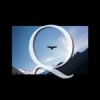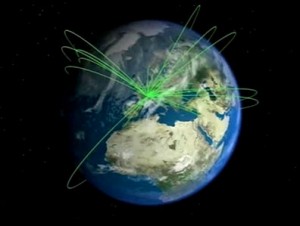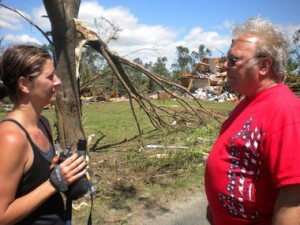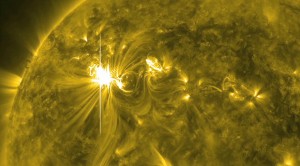 NASA is reporting that the sun erupted with one of the largest solar flares of
NASA is reporting that the sun erupted with one of the largest solar flares of 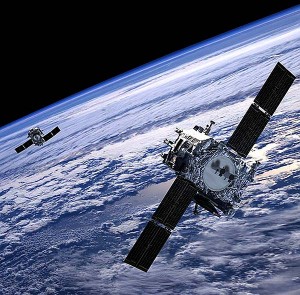 this solar cycle on March 6, 2012 at 7PM EST. This flare was categorized as an X5.4, making it the second largest flare — after an X6.9 on August 9, 2011 — since the sun’s activity segued into a period of relatively low activity called solar minimum in early 2007. The current increase in the number of X-class flares is part of the sun’s normal 11-year solar cycle, during which activity on the sun ramps up to solar maximum, which is expected to peak in late 2013. About an hour later, at 8:14 PM ET, March 6, the same region let loose an X1.3 class flare. An X1 is 5 times smaller than an X5 flare.
this solar cycle on March 6, 2012 at 7PM EST. This flare was categorized as an X5.4, making it the second largest flare — after an X6.9 on August 9, 2011 — since the sun’s activity segued into a period of relatively low activity called solar minimum in early 2007. The current increase in the number of X-class flares is part of the sun’s normal 11-year solar cycle, during which activity on the sun ramps up to solar maximum, which is expected to peak in late 2013. About an hour later, at 8:14 PM ET, March 6, the same region let loose an X1.3 class flare. An X1 is 5 times smaller than an X5 flare.
NPR is reporting that the flares will hit the earth on Thursday. The report goes on,”The flares took place about an hour apart. And when they hit Earth, the waves of magnetic fields may disrupt power grids, as well as radio-based communications. But the phenomenon might also bring auroras to the skies above residents of the northern United States, according to an interview with NASA solar physicist Alex Young, over at The Los Angeles Times. And when they hit Earth, the waves of magnetic fields may disrupt power grids, as well as radio-based communications.But the phenomenon might also bring auroras to the skies above residents of the northern United States, according to an interview with NASA solar physicist Alex Young, over at The Los Angeles Times.”
NASA gathers information from the Solar Terrestrial Relations Observatory (STEREO) and the Solar Heliospheric Observatory (SOHO). In addition, last night’s flares have sent solar particles into Earth’s atmosphere, producing a moderate solar energetic particle event, also called a solar radiation storm. These particles have been detected by NASA’s SOHO and STEREO spacecraft, and NOAA’s GOES spacecraft.
US House Passes Hydropower Development and Rural Jobs Act
